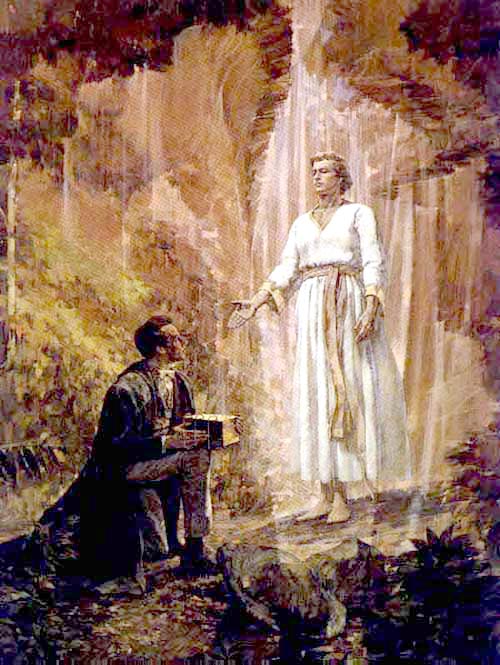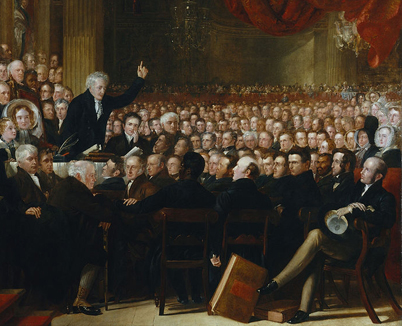Theme: the religious revivalism of the Second Great Awakening led to the desire to achieve earthly perfection, and a host of reform movements to achieve that perfection. Ultimately, this led many people into the Abolitionist movement, and led eventually to the abolition of slavery.
I. Second Great Awakening (1790-1840) – the spirit of revivalism that the Second Great Awakening spawned led to a variety of reform movements, which ultimately led to Abolitionism.
A. Charles Grandison Finney -- perhaps the leading figure of the Second Great Awakening. Finney was originally a lawyer, who preached that conversion and salvation were not the ultimate aim of the religious experience, but the beginning. Finney believed that humans were not passive objects of God’s predestined plan, but moral free agents who could choose good over evil and thereby eradicate sin, a doctrine which Finney called the “utility of benevolence.” Finney ultimately becomes the first president of Oberlin College, which itself became a hotbed of abolitionism.
1. Rochester, NY – Finney began his career in Rochester, a city which had been transformed from a sleepy little village of 300 in 1815 to a bustling city of 20,000 in 1830 by the construction of the Erie Canal. The changes this growth brought to the town disrupted life as it had been for many of the people drawn to the town by the economic opportunities the canal presented; this disruption in turn fed the need to find some grounding in sprititual life, not only in Rochester but in much of the rest of the country, as well.
B. Utopian communities
1. New Harmony – begun by Robert Owen, a Scottish industrialist and proto-socialist who was made uncomfortable by the factory system which made him his wealth. The community he founded in southern Indiana lacked the harmony which he sought to create, and failed after three years
2. Oneida Community – founded by John Humphrey Noyes after he heard a Charles Finney preach; Noyes came to believe that final conversion led to perfection and complete release from sin. He gathered a small number of followers around him at Oneida, New York.
a. Sexual practices – were restricted, among the males, to those who met certain spiritually advanced stages (principally Noyes himself); all other males were to abstain from sex. The restriction of sexual practice became one of the defining characteristics of religious reform, from practices ranging from total abstinence from sex for both males and females in sects like the Shakers, to polygamy as practiced by the Mormans.
b. “Free Love” doctrine – at heart, this doctrine was about equality between the sexes, that a man and a woman both had an equal say in whether they would become partners. This licentious behavior was shocking to many contemporaries during a time when male/female relationships were tightly constricted (the town of Norwalk, near Sandusky, began life as a free love commune)
3. Shakers
4. “Millerites” – millenarians who believed the end of the world was imminent; although founder William Miller died discredited, the Seventh Day Adventists can be traced to this movement
5. Mormons – founded by Joseph Smith, who claimed to be given the Book of Mormon by the angel Moroni, and who made a brief stop in the town of Kirkland, Ohio, before taking his followers further west. Smith created controversy wherever he stopped, and his creation of the town of Nauvoo in the mid-1840s eventually led to his being tried for treason and lynched outside of Carthage, Illinois. Brigham Young was able to keep most of Smith’s followers together under his leadership, and eventually bring them to the isolated Utah Territory.
II. Reforming Society
A. Temperance – ideology ranged from those who advocated moderation in a society, to those who wanted alcohol strictly prohibited. The latter tended to be persons of higher economic status, who wished to enjoin those of lower economic status from the boisterous behavior that heavy drinking promoted—as well as the missed work that was a consequence of over-indulging, as well.
1. Washingtonians – a working-class group that was fairly popular, who asked their followers to practice total abstinence; members tended to be more sympathetic toward other members who relapsed, which may have been both a consequence of their sympathy toward fellow workers (wanting to use temperance more as a tool of self-control and self-improvement, rather than as a tool of social control) and the reason for the popularity of the society among workers.
B. Health and Sexuality – this era witnesses the first explosion of crackpot health regimes and diets, including phrenology, hypnotism, and hydropathy (bathing and water purges—enemas)
1. Graham crackers – Sylvester Graham invented his cracker to help people curb sexual urges; they were to eat these crackers rather than engage in sexual intercourse or masturbate. Note in these reform movements both the urge to perfect society, and to impose controls upon those persons in society—controls imposed by the middle class on their own members, as well as those imposed upon the working class.
III. Abolitionism and Women’s Rights – political equality for both African Americans and women grew during this time period along parallel paths, and involved many of the same people.
1. Lane Theological Seminary – Arthur and Lewis Tappan, two wealthy New York industrialists, financed a school in Cincinnati to train abolitionist leaders. Nervous Cincinnatians convinced the school’s president, Lyman Beecher (whose daughter Harriet Beecher Stowe wrote Uncle Tom’s Cabin) to reign in some of the most active abolitionist workers, the “Lane rebels” moved north and established Oberlin College, which became the first institution to grant degrees to both African Americans and to women, as well as white men.
2. Tensions in the Anti-Slavery Movement – mainly over tactics: whether to work for reform of society, or to use the political process to force change.
a. Publications – a variety of newspapers and books began to appear advocating abolition; among the most famous were William Lloyd Garrison’s Liberator and Frederick Douglass’ North Star; a man named Elijah Lovejoy also attempted to publish an abolitionist paper, first in St. Louis and later in Alton, Illinois. He lost his life attempting to protect his press from a mob which did not appreciate the rights of a free press.
b. Shortsightedness of white abolitionists – many white abolitionists refused to consider the condition of free blacks in the North; the fact that most free black in the section found discrimination oppressive.
B. Women’s Rights – many people involved with the abolitionist movement—particularly females—also became involved with the women’s rights movement.
1. Woman’s sphere – the home, of course; however, females could become involved in causes that promoted morality, since this was not seen as outside their realm of influence. This opening led to their greater involvement in public life, grudgingly.
a. Married women’s rights – to control their own property, to custody of children in cases of marriage dissolution.
b. Attempted denial of rights – women were continually harassed when speaking out in public about matters concerning the abolition of slavery, as well as matter concerning women’s rights.
c. Tensions with male abolitionists – many male abolitionists were divided about their feelings about promoting equality for women. After Lucretia Mott and Elizabeth Cady Stanton had to sit behind a curtain and not speak out at the World Anti-Slavery Convention in London in 1840, they resolved to form a society to advocate for rights for women; in 1848 such a society was formed by women meeting in Seneca Falls, New York.











No comments:
Post a Comment